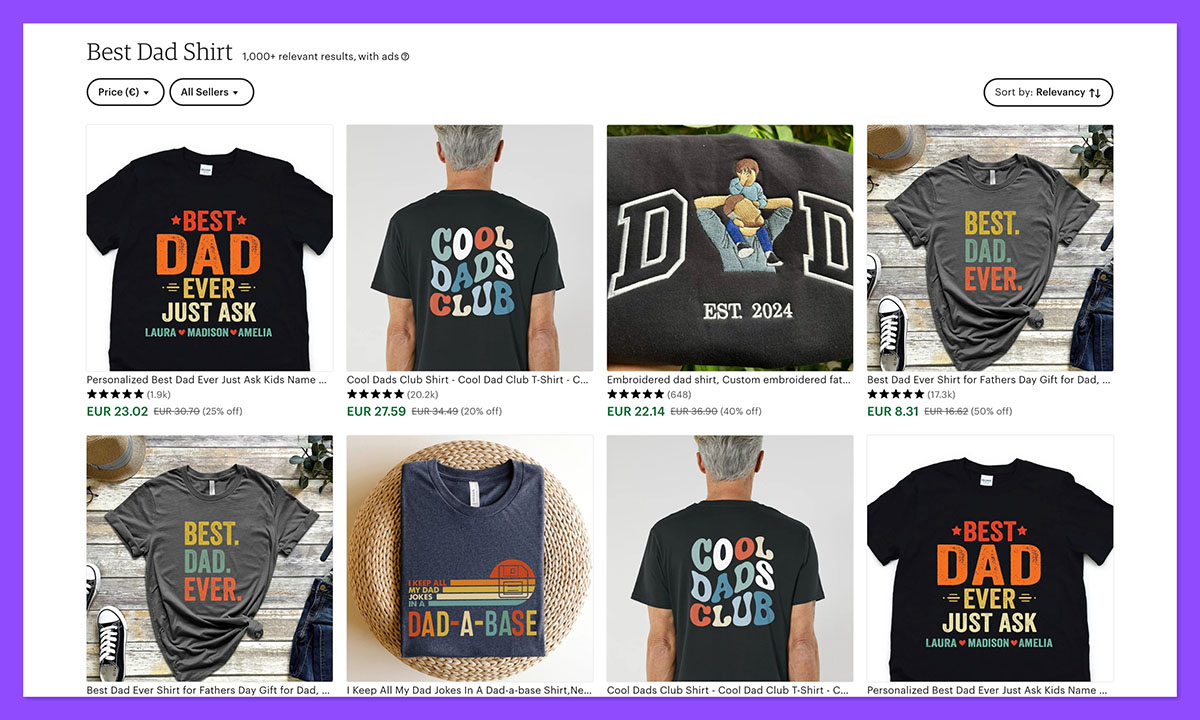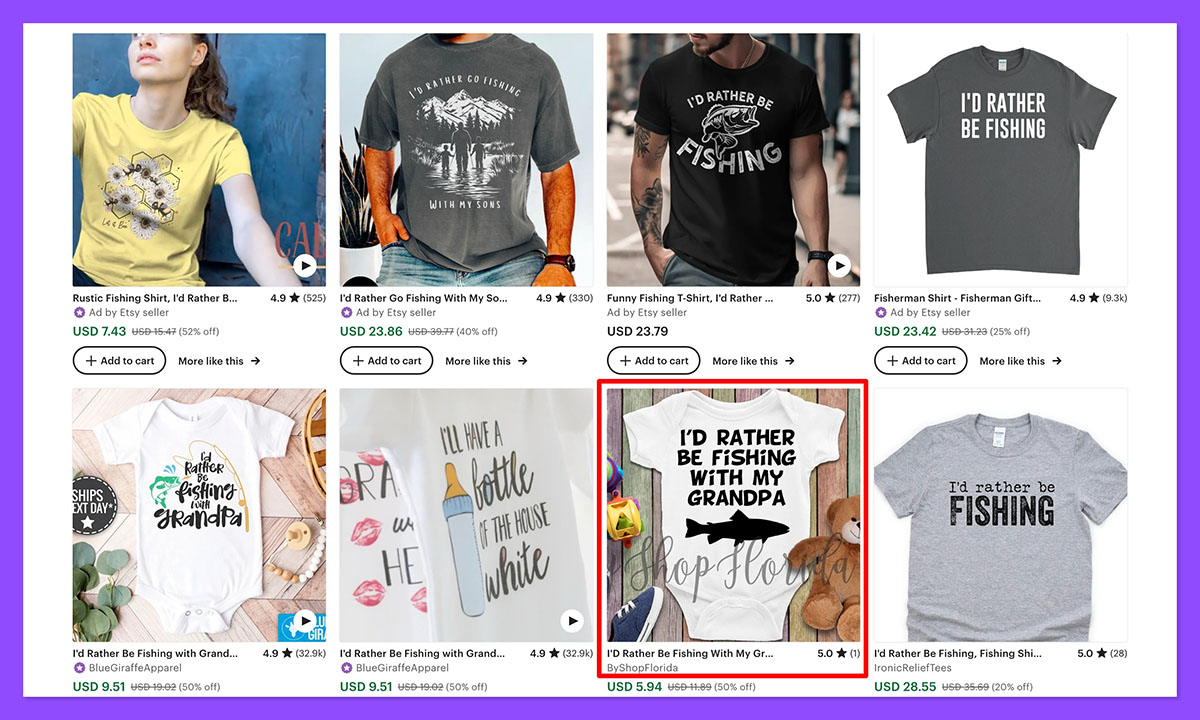When I first started in print on demand (PoD), I made the same mistake most beginners make—I chased trends.
I’d see a meme go viral and think, That would look great on a t-shirt! So I’d rush to create a design, list it, and hope for sales. Sometimes, it worked.
But more often than not, by the time my design was up, the trend had already started to die. Even if I got a few sales, it never lasted. I was always starting from scratch.
That’s when I learned the power of evergreen designs. Instead of playing the short-term game, I shifted my focus to niches and concepts that never go out of style. That’s when my business truly started to grow.
Why Trends Are a Bad Business Model
1. Trends Die Quickly
I’ve seen so many PoD sellers ride the hype wave, only to crash just as fast. One minute, their store is blowing up with orders from a trending design.
The next? Dead silence.
The moment the trend fades, their entire business dries up.
Trends are unpredictable. Even if you do catch one early, it’s usually a race to the bottom. Thousands of sellers will copy the same concept, flooding the market.
Your profit margins shrink, and before you know it, you’re stuck with a design that no one wants anymore.
2. No Long-Term Growth
If you build your entire business around trends, you’re never building an asset—just a bunch of one-hit wonders. Every time a trend dies, you’re forced to start over. That’s exhausting.
An evergreen business, on the other hand, grows steadily over time. Your designs keep selling, and your revenue compounds. Instead of constantly hunting for the next viral moment, you’re focusing on scaling what already works.
3. You Can’t Scale a Trend-Based Business
Scaling a PoD business means running ads, testing designs and reinvesting profits. But when your entire business depends on short-term trends, that strategy falls apart.
You can’t scale what isn’t consistent. If your best-selling design is only relevant for a few weeks, you can’t pour money into ads or build a long-term customer base.
That’s why focusing on evergreen niches and designs is the smarter move.
What Makes a Niche Evergreen?
An evergreen niche is one that people will always be passionate about—no matter the season, year or what’s trending.
Think about hobbies like fishing or gardening. These aren’t passing fads. People have been obsessed with them for decades and they’ll continue to be.
The same goes for professions—teachers, nurses, truck drivers, engineers—people take pride in their careers and love showing it off.
Another huge category is family roles—moms, dads, grandmas, grandpas. These relationships never stop being relevant. A well-designed “Best Dad Ever” shirt will sell just as well today as it will ten years from now.

The Niches to Avoid
Now, compare that to seasonal niches like Christmas, Halloween or New Year’s resolutions. Sure, you might make a killing in December but what about the other 11 months of the year?
Your sales will spike and then completely fall off a cliff.
Another mistake is chasing hype-based niches—like a viral TikTok phrase or a pop culture reference.
These might sell for a short time but eventually they become outdated and your store becomes a graveyard of old trends.
If you want to build a real business you need a niche that sells year-round.
How to Make Evergreen Designs That Sell
1. Pick an Evergreen Niche
The first step is making sure your niche has long-term demand. You want to create designs for communities that are passionate, engaged and always growing.
For example, dog lovers don’t just stop loving dogs. Gamers don’t just quit gaming. These are lifelong passions that guarantee an audience willing to buy.
If you’re unsure about a niche ask yourself:
- Will people still care about this in 5 years?
- Is this niche big enough to support multiple designs?
- Are there active Facebook groups, subreddits or online communities around it?
If the answer is yes, you’ve got a solid niche.
2. Create Designs That Resonate
Just because a niche is evergreen doesn’t mean any design will sell. You need to tap into emotions—humor, nostalgia, pride or identity.
Fishing Example:
A shirt that just says “Fishing” is boring. But a shirt that says “I’d rather be fishing with Grandpa”? That hits differently. It’s personal. It means something to the person buying it.

The best-selling PoD designs aren’t just about a topic—they tell a story, evoke a feeling or connect with the buyer on a deeper level.
3. Test, Learn, Scale
Once you have a few designs in an evergreen niche, it’s time to test and refine. Not every design will be a winner and that’s okay. The key is to analyze what works and double down on your bestsellers.
- If one fishing design takes off? Make variations.
- If a dog mom shirt sells well? Create different versions for specific breeds.
The more you test, the more you learn what your audience wants. And once you find a winning formula, scaling becomes easy.
Focus on the Step You’re On
I see print on demand sellers overcomplicate everything.
They stress about their website layout when they don’t even have a winning design. They worry about ad strategies before making a single sale.
They try to plan five steps ahead when they haven’t even mastered step one.
I get it—it’s easy to get caught up in the bigger picture. But the reality is, your next move should always be based on where you are right now.
So ask yourself:
- Do you need to test more designs?
- Do you need to improve product descriptions?
- Do you need to focus on ad creatives?
- Do you need to lower CPC?
Stop worrying about problems you haven’t even reached yet. Solve the current problem first, then move forward.
Consistency is King
I’m not saying evergreen designs will make you rich overnight. They won’t.
But what they will do is compound over time. The more you focus on long-term sales instead of short-term trends, the more predictable your income becomes.
You’ll have designs that sell every single day, giving you a stable foundation to grow from.I’ve seen many PoD sellers quit because they expected overnight results.
But the ones who test consistently and focus on evergreen designs? They build real businesses that stick.
So if you’re chasing trends, step back. Switch gears. Build something **that’s actually real.
And above all—stay in the game.

